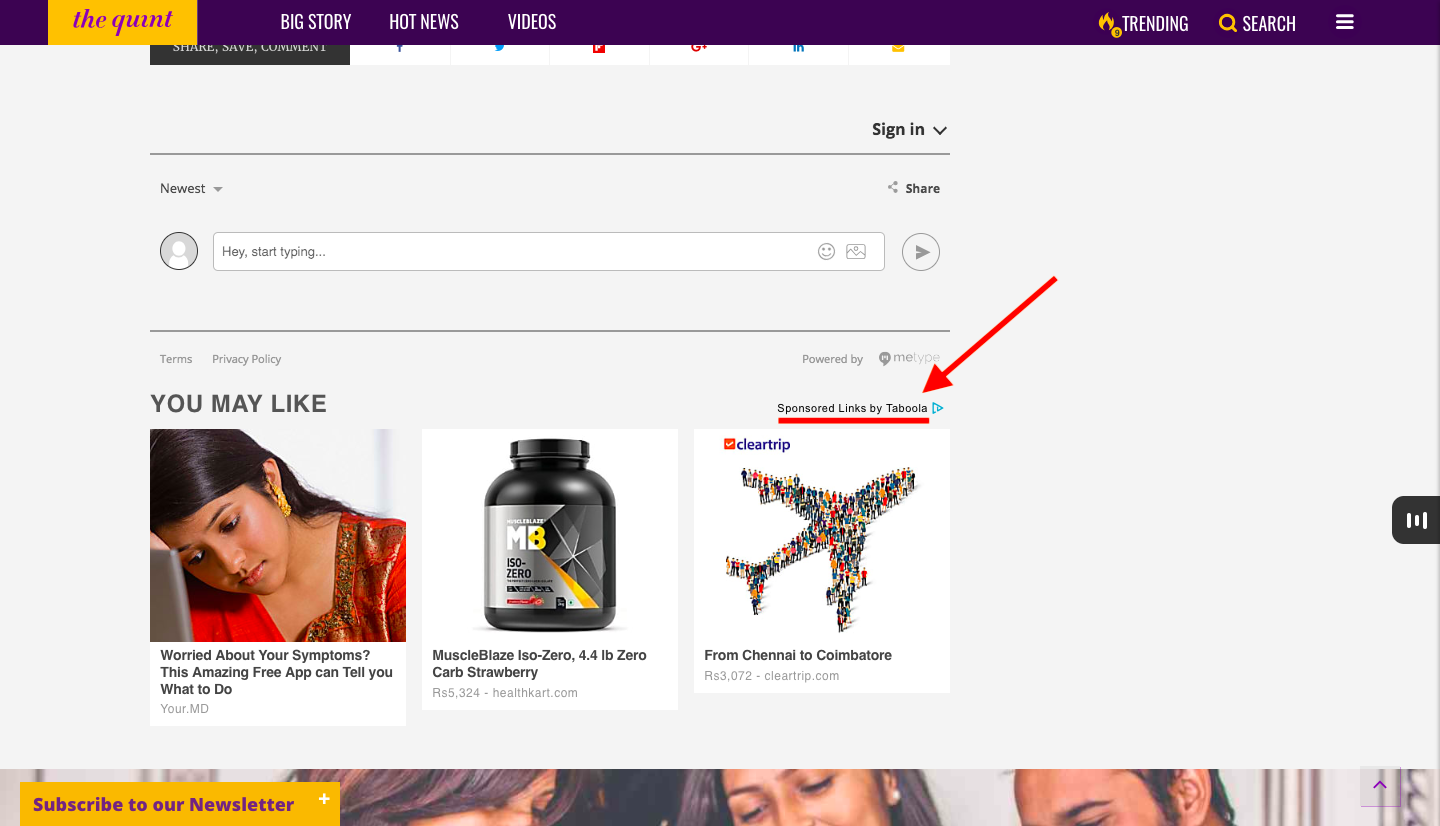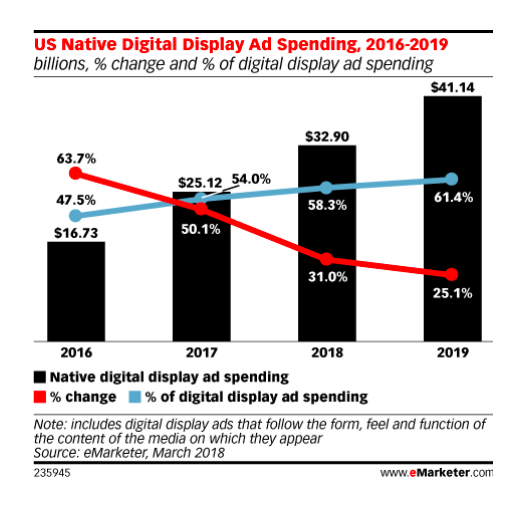According to an Adobe survey, 45% of respondents had no desire to view ads. The main reason? Most ads are intrusive. People get hit by an average of 5,000 ads per day! After a while, they just become blind to those ads.
Native advertising solves this huge psychological challenge of intrusion. These are ads that are designed to blend into the natural content of a website. The automobile and travel industries are the top industries using native advertising.
If done well, native advertising can be really good. But the risk is that sometimes people feel cheated when they find out they’ve been reading a sponsored post. But surveys have shown us that if the quality of the ad is good, it actually boosts trust in the brand.
What is native advertising?
Native advertising can be defined as a type of digital advertising that matches the function and form of the platform upon which it appears. Form refers to the design, while function refers to the role the platform plays in terms of user experience.
The beauty is that the ad blends in with the editorial content of the platform.
Let’s take a look at this page featuring Warby Parker:

From a design perspective, it looks like a normal blog post. It has a header, which gives you the feeling that this a “how to” post on building a business. There’s a blog banner right under the title. The content gives a brief story line of the company, and there’s even a quote section, just like other blog posts. Toward the end, you spot a huge CTA to check out Warby Parker’s products. Now you realize why the blog banner had the image of their product.
It’s a neat little soft sell!
What are the different types of native ads?
Some consider promoted listings on ecommerce websites and paid search ads to be native ads. While these ads do satisfy the definition of native ads, in the advertising industry, the term “native ads” refers to native ads that appear in a publication.
There are two types of native ads. Here is a look at both of them:
In-feed units: These ads are mixed with normal content. They are pretty hard to spot because they look exactly like the normal editorial content.

Recommendation widgets: These feature promoted content seen as recommendations at the end or the side of some pages. These ads may or may not look like the site’s editorial content.

Why is native advertising so effective?
Recently, people have started using neuroscience to understand the effectiveness of ads. Neuroscience is a cutting-edge life science that analyzes the brain-wave activity and pupil movements that people exhibit when exposed to ads.
Nielsen conducted a study comparing native ads and standard display ads. These were the findings:
- Native ads command two times more visual focus than standard display ads.
- When it comes to native ads, the text actually gets read. The majority of the ads are read just like normal editorial content. However, in standard display ads, the text is ignored.
- The ads’ headlines can be used to trigger specific emotions and associations with the brand.
Those are the reasons why more and more brands are turning toward native advertising. According to eMarketer, 58.3% of digital-display spending in the U.S. will be on native ads this year; in 2017, spending was 54%.
 As you can see, the trend is clearly moving in the “native” direction. It’s better if you jump on the bandwagon before it’s too late!
As you can see, the trend is clearly moving in the “native” direction. It’s better if you jump on the bandwagon before it’s too late!
How to get started with native advertising
Step 1: Decide how native advertisement fits into your marketing funnel
Before you splash your ad budget, you need to figure out why you are doing this. There should be a very specific goal. Otherwise, you’ll never be able to determine whether it’s working or not. The basic question to ask is, “How does native advertising fit into our overall funnel?”
Here are some examples to give you some perspective:
- If you are looking for fresh leads at the top of the funnel, it might make sense to create a simple video that boosts your brand.
- If you are looking to warm up leads, it would make sense to retarget your existing customers’ in-depth articles that slightly mention your brand without being too sales-y.
- If you are looking for conversions, you have to retarget your leads with case studies or even product landing pages!
Bottom line is that you need to have a sound native-advertising strategy.
Step 2: Do some competitive analysis
Competitive analysis is the most overlooked yet most important part of native advertising. If you can get access to the strategies used by your competitors, you are already one step ahead. Most companies spend tons of money in the initial stages to find the right formula.
What if you had access to their core strategies?
How about getting to know the publishers they’ve been targeting all these years, the ad networks they are working with, the creatives they’re using in each website, and even the landing pages they are directing traffic to?
There are free competition analysis tools, such as Adbeat, that give you in-depth knowledge on what your competitors and even other companies are doing.
This sort of intel will make your native ads much more powerful.
Step 3: Create a landing page for your native ads
Getting click-throughs is just one part of an ad. Once you get people’s attention, how do you make the most of it? This depends on the landing page you are using.
After going through hundreds of landing pages, we found that there are seven types of landing pages that work very well for native ads.
We’ve also come up with a formula to write awesome landing-page copy for native ads.
Step 4: Decide how you want to run your native ads
There are two main ways to get your ads out there:
- Talk directly to publishers.
- Get access to top publishers via ad networks.
Let’s look into both:
1. Directly reaching out to publishers: There are many sites, such as TNW, BuzzFeed, and Forbes, that are open to inquiries. You can just send them an email and start negotiating. The advantages are manifold:
- You get the best ad placements.
- You will work with a dedicated team that will make sure your ads give you maximum results.
However, these publishers will require you to spend a minimum amount, which can be expensive. If you cannot afford this, it’s better to go for an ad network.
2. Going through ad networks: Ad networks are services that act as middlemen between large publications and advertisers like you. The advantages they bring to the table include the following:
- You can get visibility on a number of publishers at the same time, without spending too much money.
- If you find a good ad-network partner, they will help you in strategizing the whole campaign.
There are many ad networks out there.
Check out our guide on how to choose the best ad network for your native ad campaign.
Native advertising: Examples and case studies
The best way to learn native advertising is by looking into the strategies of other companies. In our experience, every company has something very valuable to teach. Even if they’ve failed in native advertising, you can always learn from the mistakes and make sure you don’t commit the same ones.
We’ve compiled some of the most common deadly mistakes most people make while starting out with native advertising.
We do Industry Roundups and individual case studies from time to time. Here are a few for your reference:
Native advertising industry roundups
- How top fashion retailers are using native ads: This study looks into the strategies used by four top fashion retailers. These are million-dollar companies spending tons of money. It’s not just celebrity gossip these brands rely on. You can check out the case study here.
- How meal-kit delivery businesses are battling it out with native ads: This study analyzes the strategies used in the billion-dollar meal-kit delivery industry. It’s a yummy showdown with a lot of exciting tips to take away. Check it out here.
Native advertising examples
- How Answers. com makes millions in revenue using native ads: This is an in-depth study that focuses on how Answers.com is using native advertising to generate millions of dollars. These hacks can be applied in any industry with a few tweaks. You can check out the case study here.
This list will be constantly updated, so make sure you bookmark this page and come back later.
Trackbacks/Pingbacks